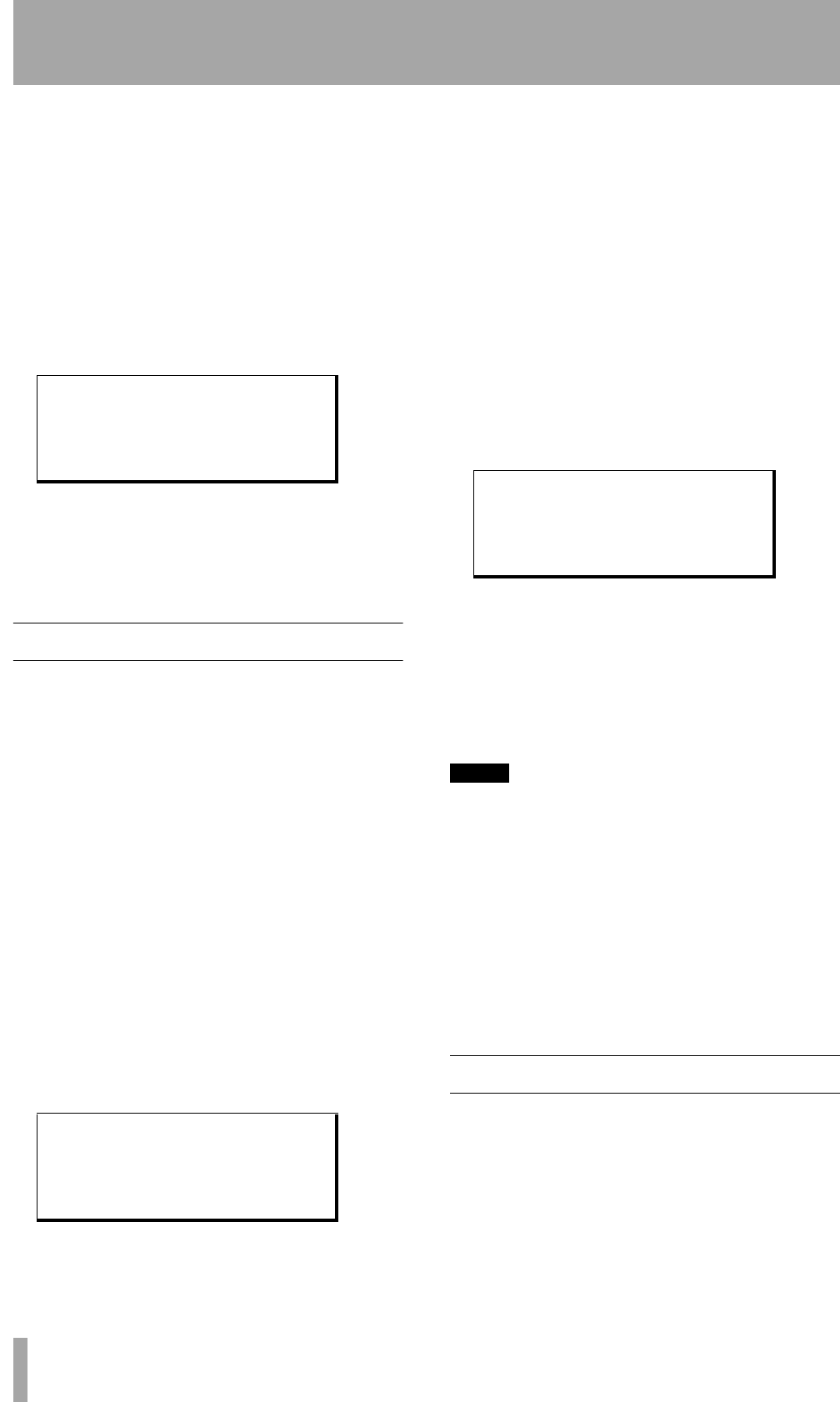
9 – Operations related to timecode–Selecting the frame rate
62 TASCAM DA-98HR
timecode previously recorded on the timecode
track will be erased!).
9.3.8 Checking external timecode
External timecode can also be checked in another
way, as described below. This method is useful for
checking the frame rate of incoming timecode, if you
are not sure what frame rate has been recorded or is
being generated by the timecode source.
1 Go to menu group E, and move the cursor to
Ext TC:
2 Incoming timecode is displayed on the bottom
line, together with the frame rate of the
timecode. If no incoming timecode is currently
being received, the screen shows dashes
(
--:--:--:--).
9.4 Selecting the frame rate
The DA-98HR can use the following standards when
recording and using timecode (including timecode
synthesized from ABS): 30 non-drop, 30 drop, 29.97
non-drop, 29.97 drop, 25, and 24 frames per second
(fps).
When using the DA-98HR to chase to a timecode
master, the system frame rate on the DA-98HR must
match the frame rate of the timecode master, other-
wise chase operations are not possible.
The frame rate is automatically set when a tape
which has been striped with timecode is inserted, or
if power is switched on with a striped tape already
inserted in the unit. The frame rate recorded on the
tape is then used as the system frame rate.
To change the frame rate in other cases, follow the
procedure below:
1 Go to menu group 5, move the cursor to
TC
Frame
, and press ENTER:
2 Use the § and ¶ keys to change the system
frame rate for your project.
3 The
TC Track field shows the current
tape stripe frame rate and cannot be changed.
9.4.1 Pull up and pull down (Fs shift)
When working in film post-production with NTSC
telecine equipment, the frame rate of film (24 fps)
and the NTSC color frame rate (29.97) do not form a
simple mathematical ratio, and the sampling frequen-
cies of either 44.1kHz and 48kHz are therefore
affected on transfer back to film.
To avoid this, pull up and pull down functions are
provided to adjust sampling frequencies to drop-
frame rates, etc.
1 Go to menu group 8, move the cursor to
Fs
Shift
, and press ENTER:
2 Use the § and ¶ keys to select between
Pull Down 30NDF, Pull UP
29.97 NDF
, Pull UP 29.97
DF
, Pull Down 30DF and Off.
The triangular
PULL UP and PULL DOWN
indicators by the tape counter light if the set-
ting is anything other than
Off.
NOTE
S
This setting is
not
memorized in the backup memory–you
must reset it every time the DA-98HR is turned off and on
again.
The clock source must be set to
INT
when using the Fs
shift function to pull up, and to
VIDEO
when using this
function to pull down.
If vari speed is enabled (7.5, “Vari speed (pitch control)”), it
is not possible to use the Fs shift function.
When the Fs shift mode is operational, you cannot change
the timecode frame rate (see 9.4, “Selecting the frame
rate”).
9.5 Timecode input and output
Only timecode (not ABS timing) can be received via
the
TIME CODE IN jack.
The DA-98HR can, however, send both timecode
recorded on tape, as well as ABS timings as time-
code, in addition to using this time reference for mul-
tiple DTRS unit synchronization (9.5.2, “Timecode
output”).
˘Ext TC Abs Diff
Tape TC Rel Diff
Gen TC ABS Time
01:02:48:17 30DF
TC Frame Mode
TC Track System TC
none 30NDF
Fs Shift Mode
off


















